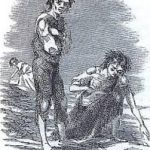One way that artists try and commemorate the individuals from the Irish famine is through memorials. The vast variety of memorials that were built for these people are in a great abundance. One of the most meaningful memorials that was built for the Irish people is now located in Bailick Park, in Midleton, County Cork, Ireland called Kindred Spirits. The memorial was built in the year 2015, only about 3 years ago, by the sculptor Alex Pentek. The memorial consists of nine stainless-steel feathers all proposed in a circle to try and symbolize a soup bowl to represent the need for help and assistance for the

need for food. Alex Pentek is an Irish artist who has a growing portfolio of national and international work that explores different site specific ideas in a broad range of materials. With over 20 large scale permanent works completed in Ireland, Northern Ireland and Canada, long time interests in science, origami and music inform Pentek’s work on both practical and philosophical levels. This memorial also symbolizes the help that the Irish people had gotten from the Choctaw tribe during the famine. The assistance of these individuals was a very crucial part in the famine history because almost a decade before the tribe had made the donation to the irish people they were being forced out of their homeland to walk almost 1,200 miles of land because the United States did not think they were fit to be there anymore. This movement was called the Trail of Tears. Even though the Choctaw tribe was still not stable themselves from the Trail of Tears, they knew what it felt like to be in need and having to leave their homeland. They donated anywhere between $4,500 to $10,000 US dollars to the Irish people. Since we have talked a lot about NYC, we might also want to look at the memorial that is posted in Battery Park, NYC. The Memorial represents a rural Irish landscape with an abandoned stone cottage, stone walls, fallow potato fields and the flora on the north Connacht wetlands. It is both a metaphor for the Great Irish Famine and a reminder that hunger today is often the result of lack of access to land. The 96’ x 170’ Memorial, designed by artist Brian Tolle, contains stones from each of Ireland’s 32 counties and is elevated on a limestone plinth. Along the base are bands of texts separated by layers of imported Kilkenny limestone. The text, which combines the history of the Great Famine with contemporary reports on world hunger, is cast as shadow onto illuminated frosted glass panels. And as described
Some other events that had happened to the Irish people that unfortunately did not get commemorated, was the Irish Draft Riots that had occurred in NYC. CLICK HERE to learn more on the Draft Riots!
CLICK HERE to go back to the main page










